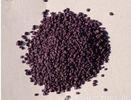Fodders & Feed
Farm Pesticides Nematicides Carbosulfan 5%GR CAS 55285-14-8 With Stomach Action
carbosulfan 5%GR
Description
Farm Pesticides Nematicides Carbosulfan 5%GR CAS 55285-14-8 With Stomach Action
?
?
Carbosulfan
TC & FORMULATION: 90%TC, 5%GR, 200G/L EC,35% ZGF
?
?
?
Structure Formula:
?
NOMENCLATURE
Common name carbosulfan (BSI, ANSI, draft E-ISO, (m) draft F-ISO)
IUPAC name 2,3-dihydro-2,2-dimethylbenzofuran-7-yl (dibutylaminothio)methylcarbamate
Chemical Abstracts name 2,3-dihydro-2,2-dimethyl-7-benzofuranyl [(dibutylamino)thio]methylcarbamate
CAS RN [55285-14-8] EEC no. 259-565-9
?
PHYSICAL CHEMISTRY
Mol. wt. 380.6 M.f. C20H32N2O3S Form Orange to brown clear, viscous liquid. M.p. No clearly defined m.p. B.p. Thermally unstable when vacuum distilled (65 mmHg). V.p. 3.58 ′ 10-2 mPa (25 °C) KOW logP = 5.4 Henry 4.66 ′ 10-3 Pa m3 mol-1 (calc.) S.g./density 1.054 (20 oC) Solubility In water 3 ppm (25 oC). Miscible with most organic solvents, e.g. xylene, hexane, chloroform, dichloromethane, methanol, ethanol, acetone, etc. Stability Hydrolysed in aqueous media; DT50 0.2 h (pH 5), 11.4 h (pH 7), 173.3 h (pH 9). F.p. 40 oC (closed cup)
?
APPLICATIONS
Biochemistry Cholinesterase inhibitor; activity is due to in vivo cleavage of the N-S bond, resulting in conversion to carbofuran. Mode of action Systemic insecticide with contact and stomach action. Uses Control of a wide range of soil-dwelling and foliar insect pests. Examples of uses include control of millipedes, springtails, symphylids, wireworms, pygmy mangold beetles, frit flies, white grubs, aphids, caterpillars, flea beetles, Colorado beetles, stem borers, leafhoppers, planthoppers, codling moth, scales and free-living nematodes. The product is used in a wide range of crops, e.g. cotton, sugar beet, potatoes, rice, top fruit, citrus, maize, vegetables, sugar cane and coffee. Formulation types CS; DP; EC; GR; UL; WP. Compatibility Compatible with liquid fertilizers.
?
MAMMALIAN TOXICOLOGY
Reviews FAO/WHO 47, 49 (see part 2 of the Bibliography). Oral Acute oral LD50 for male rats 250, female rats 185 mg/kg. Skin and eye Acute percutaneous LD50 for rabbits >2000 mg/kg. Moderate skin irritant; not an eye irritant. Inhalation LC50 (1 h) for male rats 1.53, female rats 0.61 mg/l air. NOEL (2 y) (oncogenic) for rats and mice 20 mg/kg diet. ADI (JMPR) 0.01 mg/kg b.w. [1986]. Toxicity class WHO (a.i.) II EC classification T; R23/24| R43| N; R50, R53 ? ECOTOXICOLOGY
Birds Acute oral LD50 for mallard ducks 10, quail 82, pheasants 20 mg/kg. Fish LC50 (96 h) for bluegill sunfish 0.015, trout 0.042 mg/l. Daphnia LC50 (48 h) 1.5 mg/l. Algae EC50 (96 h) 20 mg/l. Bees Toxic to bees; LD50 (24 h, oral) 1.046/bee; (24 h, contact) 0.28/bee. Worms Not toxic. Other beneficial spp. Potentially harmful. ? ENVIRONMENTAL FATE
EHC 64 (WHO, 1986; a review of carbamate insecticides in general). Animals In rats, following oral administration, rapidly metabolised by hydrolysis, oxidation and conjugation, forming carbofuran methylol, carbofuran phenol, and their 3-hydroxy and 3-keto derivatives; the metabolites are rapidly excreted. Plants Metabolites include carbofuran (q.v.) and 3-hydroxycarbofuran. Soil/Environment In soil, rapidly degraded under both aerobic and anaerobic conditions; DT50 c. 3-30 d; the principal metabolite is carbofuran (q.v.). Under field conditions, carbosulfan and carbofuran are unlikely to leach to groundwater.
?
?
Read More
Shanghai Molotus Chemical Co.,ltd
Insecticide Pesticide,Agricultural Pesticides,Fungicide Pesticide
Address: Room 402 Shangfu Building No. 553 Maotai Road,
Shanghai, Shanghai
China, 200000
Tel: 86-150-70596596
Fax: 86-150-70596596


